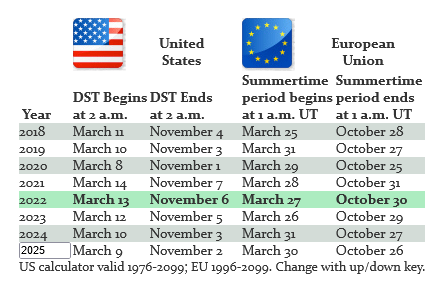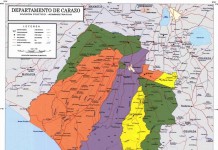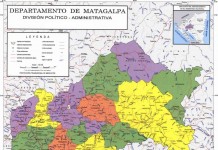
Domingo, 10 de Marzo de 2024
On Sunday, March 10, 2024, almost all of the United States, and 78 other countries, will set their clocks forward one hour for Daylight Saving Time.
Every year, DST starts on the second Sunday of March, when our clocks will jump forward an hour at 2 a.m. DST ends on first Sunday of November.
When we change our clocks
Most of the United States begins Daylight Saving Time at 2:00 a.m. on the second Sunday in March and reverts to standard time on the first Sunday in November. In the U.S., each time zone switches at a different time.
In the European Union, Summer Time begins and ends at 1:00 a.m. Universal Time (Greenwich Mean Time). It begins the last Sunday in March and ends the last Sunday in October. In the EU, all time zones change at the same moment.

Every year, DST starts on the second Sunday of March, when our clocks will jump forward an hour at 2 a.m. DST ends on first Sunday of November.
These days, most of the electronics we use as timekeepers — smart phones and watches, cable boxes and even some clocks — will automatically make the correction.

When in the morning?
In the U.S., clocks change at 2:00 a.m. local time. In spring, clocks spring forward from 1:59 a.m. to 3:00 a.m.; in fall, clocks fall back from 1:59 a.m. to 1:00 a.m. In the EU, clocks change at 1:00 a.m. Universal Time. In spring, clocks spring forward from 12:59 a.m. to 2:00 a.m.; in fall, clocks fall back from 1:59 a.m. to 1:00 a.m.
In the United States, Daylight Saving Time commences at 2:00 a.m. to minimize disruption. However, many states restrict bars from serving alcohol between 2:00 a.m. and 6:00 a.m. At 2:00 a.m. in the fall, however, the time switches back one hour. So, can bars serve alcohol for that additional hour? Some states claim that bars actually stop serving liquor at 1:59 a.m., so they have already stopped serving when the time reverts to Standard Time. Other states solve the problem by saying that liquor can be served until “two hours after midnight.” In practice, however, many establishments stay open an extra hour in the fall.
In the U.S., 2:00 a.m. was originally chosen as the changeover time because it was practical and minimized disruption. Most people were at home and this was the time when the fewest trains were running. It is late enough to minimally affect bars and restaurants, and it prevents the day from switching to yesterday, which would be confusing. It is early enough that the entire continental U.S. switches by daybreak, and the changeover occurs before most early shift workers and early churchgoers are affected.
Some U.S. areas
For the U.S. and its territories, Daylight Saving Time is NOT observed in: Hawaii, American Samoa, Guam, Puerto Rico, the Virgin Islands, the Commonwealth of Northern Mariana Islands, and Arizona. The Navajo Nation participates in the Daylight Saving Time policy, even in Arizona, due to its large size and location in three states.
But Arizona asked for – and was eventually granted an exemption. According to an Arizona Republic editorial from 1969, the reason was the state’s extreme heat. If Arizona were to observe Daylight Saving Time, the sun would stay out until 9 p.m. in the summer (instead of 8 p.m., like it does currently).
Indiana was the last state to join in on Daylight Saving Time, just over a decade ago.
A safety reminder
Many fire departments encourage people to change the batteries in their smoke detectors when they change their clocks because Daylight Saving Time provides a convenient reminder. “A working smoke detector more than doubles a person’s chances of surviving a home fire,” says William McNabb of the Troy Fire Department in Michigan. More than 90 percent of homes in the United States have smoke detectors, but one-third are estimated to have dead or missing batteries.
And with the extended sunny evening also comes the semi-annual debate over whether the almost 100-year-old practice is outmoded.
Daylight saving started in 1918 after “war time” was established as a way to conserve fuel. It has since been adjusted twice, most recently in 2007 when it was extended by a month due to the Energy Policy Act of 2005.
But does it still work? Citing a study out of Indiana, many have said it actually increases electricity bills due to the demand for air conditioning, which led to a 1 percent increase in overall electricity consumption after 2006 when the state adopted Daylight Saving Time.
However, many favor the practice just because they like the extra light on the tail-end of the day.
Although 78 countries observe DST, including many European nations, it is not in use in the industrialized nations of Russia, China, India and Japan.
REFERENCIAS:
- Wikipedia.
- Daylight Saving Time – When we change our clocks (webexhibits)
- Clock Changes in Washington DC, USA in 2017 (Time and Date)
323,264 total views, 1 views today


























